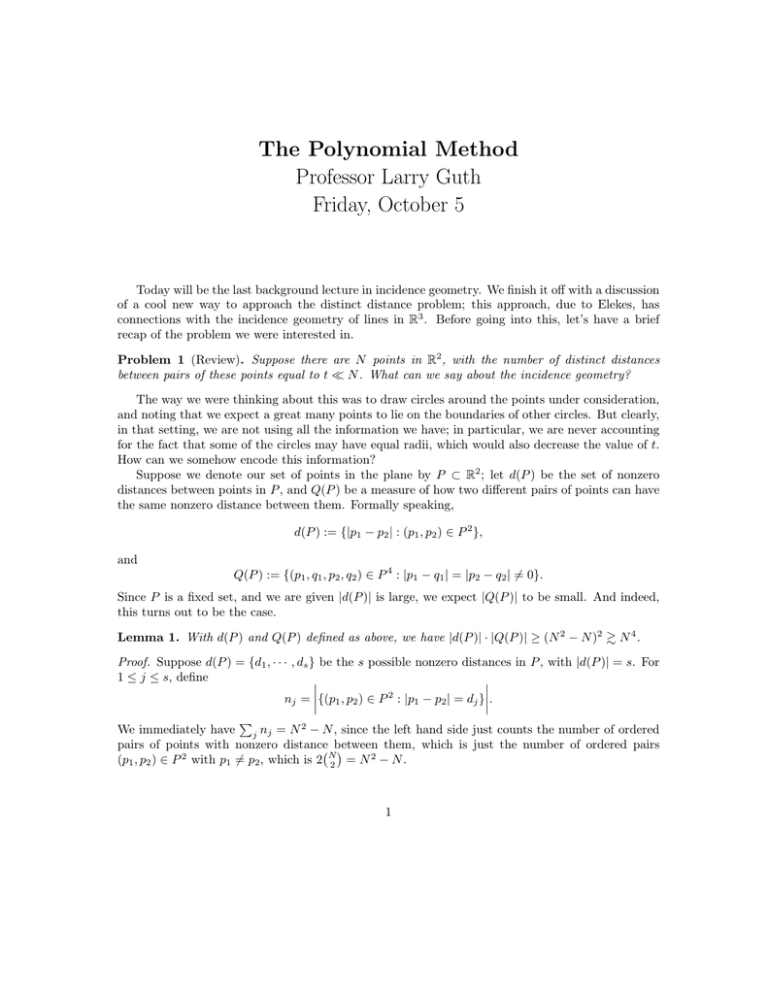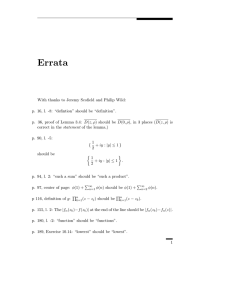The Polynomial Method Professor Larry Guth Friday, October 5
advertisement

The Polynomial Method
Professor Larry Guth
Friday, October 5
Today will be the last background lecture in incidence geometry. We finish it off with a discussion
of a cool new way to approach the distinct distance problem; this approach, due to Elekes, has
connections with the incidence geometry of lines in R3 . Before going into this, let’s have a brief
recap of the problem we were interested in.
Problem 1 (Review). Suppose there are N points in R2 , with the number of distinct distances
between pairs of these points equal to t N . What can we say about the incidence geometry?
The way we were thinking about this was to draw circles around the points under consideration,
and noting that we expect a great many points to lie on the boundaries of other circles. But clearly,
in that setting, we are not using all the information we have; in particular, we are never accounting
for the fact that some of the circles may have equal radii, which would also decrease the value of t.
How can we somehow encode this information?
Suppose we denote our set of points in the plane by P ⊂ R2 ; let d(P ) be the set of nonzero
distances between points in P , and Q(P ) be a measure of how two different pairs of points can have
the same nonzero distance between them. Formally speaking,
d(P ) := {|p1 − p2 | : (p1 , p2 ) ∈ P 2 },
and
Q(P ) := {(p1 , q1 , p2 , q2 ) ∈ P 4 : |p1 − q1 | = |p2 − q2 | =
6 0}.
Since P is a fixed set, and we are given |d(P )| is large, we expect |Q(P )| to be small. And indeed,
this turns out to be the case.
Lemma 1. With d(P ) and Q(P ) defined as above, we have |d(P )| · |Q(P )| ≥ (N 2 − N )2 & N 4 .
Proof. Suppose d(P ) = {d1 , · · · , ds } be the s possible nonzero distances in P , with |d(P )| = s. For
1 ≤ j ≤ s, define
2
nj = {(p1 , p2 ) ∈ P : |p1 − p2 | = dj }.
P
We immediately have j nj = N 2 − N , since the left hand side just counts the number of ordered
pairs of points with nonzero distance between
them, which is just the number of ordered pairs
(p1 , p2 ) ∈ P 2 with p1 6= p2 , which is 2 N2 = N 2 − N .
1
P
Now, we also have |Q(P )| = j n2j . This is because we can pick some distance dj , and then
count (p1 , q1 , p2 , q2 ) with |p1 − q1 | = |p2 − q2 | = dj . So we want to choose two elements1 from the
set {(p1 , p2 ) ∈ P 2 : |p1 − p2 | = dj }, which can be done in n2j ways. Putting everything together, we
can combine them using Cauchy-Schwarz as follows:
N2 − N =
s
X
j=1
1/2
1/2
s
s
X
X
nj ≤
n2j ·
1
= |Q(P )|1/2 · s1/2 = |Q(P )|1/2 · |d(P )|1/2 ,
j=1
j=1
so that |Q(P )| · |d(P )| ≥ (N 2 − N )2 & N 4 , as desired.
Lemma 1 is not surprising, because if there are few distances, we expect there to be a lot of
quadruples. We want to somehow count these quadruples in another way so as to preserve some
more information. To this end, define G to be the group of orientation-preserving rigid motions of
the plane.
Lemma 2. Suppose p1 6= p2 . Then we have |p1 − q1 | = |p2 − q2 | if and only if there exists a unique
g ∈ G such that g(p1 ) = p2 and g(q1 ) = q2 .
Proof. This is trivial, essentially by inspection. For the =⇒ direction, note that there is certainly
some g ∈ G with g(p1 ) = p2 and g(q1 ) = g(q2 ), defined by first taking p1 to p2 by a translation,
and then rotating about p1 until q1 goes to q2 . Uniqueness follows from the uniqueness of these two
steps. The ⇐= direction is trivial from the fact that G preserves orientations.
Now, which rigid motions take p1 to p2 ? To better answer this question, we need to somehow
find geometric structures that encode this group theoretic information. So let
Sp1 ,p2 := {g ∈ G : g(p1 ) = p2 }.
This is a 1-dimensional curve in G, which is a 3-dimensional Lie group. We can now restate Lemma
2 in a slightly different way (the proof is the same, hence omitted). Furthermore, define S :=
{Sp1 ,p2 }p1 ,p2 ∈P . In other words, S is the collection of all these curves inside G. Clearly, since
|P | = N , S consists of N 2 curves in G.
Lemma 3. Suppose p1 6= p2 . Then,
|p1 − q1 | = |p2 − q2 | =⇒ |Sp1 ,p2 ∩ Sq1 ,q2 | = 1;
|p1 − q1 | =
6 |p2 − q2 | =⇒ |Sp1 ,p2 ∩ Sq1 ,q2 | = 0.
The problem, therefore, reduces to looking at the incidence pattern of curves in S. It is simple to
check that a point lies on two of these curves if and only if it corresponds to exactly two quadruples,
and a point lies on three of these curves if and only if it corresponds to exactly three quadruples,
and so on. This naturally gives way to the following definition.
G=k := {g ∈ G : g lies in exactly k curves of S.}.
1 Note that we do not need distinct elements here, because of the way we have defined Q(P ), although this
observation does not matter too much.
2
Figure 1: The bold lines represent curves in S. The point on the left represents six quadruples, while
the one on the right represents just two.
Furthermore, let E : Q(P ) → G be given by Lemma 3, where E is the map that takes any
quadruple to the corresponding element g ∈ G. Since quadruples correspond to at least two curves
in S intersecting, it follows that
[
im(E) ⊆
G=k .
k≥2
Now consider some g ∈ G=k . Since the order of curves within the quadruples does not matter, we
also have
−1 E (g) = 2 k ,
2
since any two of the curves through g in S are mapped by E to g, with the factor of 2 arising due
to the fact that we consider ordered pairs. The following lemma is immediate.
Lemma 4. We have the estimate
|Q(P )| =
X
k≥2
k
|G=k | · 2
.
2
Proof. This is immediate from
the previous paragraph; any quadruple corresponds to precisely one
k, and in G=k , precisely 2 k2 quadruples map to the same point.
Usually, instead of the somewhat awkward G=k , we find it easier to deal with the quantity
Gk := {g ∈ G : g lies in ≥ k curves in S}.
With that definition, Lemma 4 can be rewritten as
P
Lemma 5. We have |Q(P )| ∼ 2 k≥2 k|Gk |.
3
Proof. Using Lemma 4, we immediately get
|Q(P )| =
X
k≥2
=
X
=
X
=
X
=
X
k
|G=k | · 2
2
(|Gk | − |Gk+1 |) (k 2 − k)
k≥2
|G` | · (`2 − `) − ((` − 1)2 − (` − 1))
`≥2
|G` | · `2 − ` − `2 + 2` − 1 − ` + 1
`≥2
|G` | · (2` − 2)
`≥2
∼2
X
` · |G` |.
`≥2
Another way to look at Gk is to notice the following alternative formulation.
Lemma 6. We have
Gk = {g ∈ G : |gP ∩ P | ≥ k}.
Proof. This follows trivially from the way we defined the group G. A way to view any g ∈ G is to
note that triangles transform to congruent (orientation-preserving) triangles under g, and then note
that for each such transformation, the image is in both gP and in P .
Figure 2: Triangles map to congruent triangles under g ∈ G.
Since this kind of generalizes specific notions of symmetry (relaxing the condition gP = P a little
bit), these can be thought of as “partial” symmetries, in a loose sense of the term.
It is time for an example.
Example. Suppose P is an s × s square grid, with N = s2 . What is |Gs2 |? This is easy, because
the only transformations where all s2 of the points map to themselves in some order are just the
four rotations (by 0, π/2, π and 3π/2 respectively), and hence, |Gs2 | = 4. What about Gs2 /10 ? For
this and other similar examples, it can be proven that |Gk | . N 3 k −2 for all 2 ≤ k . N/10; the
proof is nontrivial, and will be presented later using the polynomial method. It is worth remarking,
however, that a lower bound of ∼ s2 can be immediately seen by “shifting” along both axes. The
result above used to be a conjecture, so we state it for the sake of completeness. We will prove it
later in class.
4
We now come to the two major conjectures due to Elekes and Sharir that we are concerned with.
The proofs are left for later. We state the first one now, and state the second one a little later in
the explosition.
Conjecture 1 (ES1). If P ⊂ R2 is defined as above, with |P | = N , and 2 ≤ k ≤ N , then
|Gk | . N 3 k −2 .
At the outset, note that if Conjecture 1 were true, it would have a couple of nice immediate
corollaries.
P
P
Corollary. We have |Q(P )| . 2 k≥2 k|Gk | . k≥2 N 3 k −1 . N 3 log(N ).
Corollary. We have |d(P )| & N 4 /|Q(P )| & N/ log(N ).
This chain of consequences will be shown to be true using the polynomial method. For now, let
us make a few remarks about the tightness of the bounds given: the first corollary can be shown to
be tight, up to a constant factor, since each inequality within the statement is essentially tight. The
second, however, is unclear, since we used Cauchy-Schwarz in getting the result, and so we could
have
plost quite a bit of sharpness. In fact, probabilistically, it is reasonable to expect something like
N/ log(N ) for arbitrary d(P ). In fact, recall that we proved this exact expression earlier for the
square grid.
Let’s work with some specific instances of these rigid motions. First we have the translations
T ⊂ G. As a group, it is obvious that T is congruent to R2 . So now, we have the following lemma.
Lemma 7. We have |T ∩ Gk | . N 3 k −2 .
Proof. Consider the set of translation quadruples QT ⊂ Q(P ), defined as
QT := {(p1 , q1 , p2 , q2 ) ∈ P 4 : p1 − q1 = p2 − q2 6= 0}.
First observe that |QT | . N 3 , since as soon as we pick any three of the points p1 , q1 , p2 , q2 , there
remains at most one choice for the fourth one. Recall our definition of the map E from our earlier
discussions. Clearly, that map induces a map between the subgrups E : QT → T , where the left side
sits inside Q(P ) and the right side sits inside G, in the same way as before. So our earlier arguments
follow through within these subgroups, if g ∈ Gk , then |E −1 (g)| ∼ k 2 . In particular, as before, we
have
k
|QT | & |Gk ∩ T | · 2
,
2
that is,
N 3 & |Gk ∩ T | · k 2 ⇐⇒ |T ∩ Gk | . N 3 k −2 ,
as desired.
It remains to deal with G0 := G/T . In fact, we can reduce this to the study of the incidence
theory of lines and points in three-dimensional Euclidean space. We can do this by a process called
“straightening”. To this end, observe that G0 can be viewed as the group of rotations about a
unique fixed point (x, y) ∈ R2 by a unique angle θ ∈ (0, 2π), where 0 is excluded because we want
nontrivial rigid motions. So now we can define the map ρ : G0 → R3 by
ρ(x, y, θ) = (x, y, cot(θ/2)).
Before we can proceed further, we need the following proposition.
5
Proposition 1. For any p, q ∈ P , the curve ρ(Sp,q ∩ G0 ) is a straight line in R3 .
Proof. The key is to notice that when we rotate from p to q, the point of rotation lies on the
perpendicular bisector of p and q. A little bit of trigonometry then yields the result.
q
v
p
In the diagram, v is the perpendicular bisector of q and p, and is of length |q −p|/2. Furthermore,
it represents the rotation of (q − p)/2 by π/2 in the positive direction.
We can strengthen the above proposition a little bit.
2 q1 −p1
Proposition 2. For any p, q ∈ R2 , let v = ( p2 −q
2 ,
2 ), that is, v is the vector perpendicular to
p − q with length |p − q|/2. Furthermore, let a = (p + q)/2. Then, the curve ρ(Sp,q ∩ G0 ) is the line
parametrized by `p,q : t 7→ (a + tv, t).
Proof. We have the following diagram.
q
θ/2
v
(x, y)
p
If g ∈ Sp,q , suppose g has coordinates (x, y, θ). Now, we know (x, y) lies in the perpendicular
bisector of the line segment pq, so that (x, y) = a + tv for some t. To find the t, simply observe that
cot(θ/2) = t · |v|/|v| = t, to finish off the proof.
Let us put everything together now. Define L = {`p,q }p,q∈P be the set under consideration,
with ∼ N 2 lines by easy arguments. |G0k | is the number of points that lie on ≥ k lines in L . Note
that the incidence geometry depends on whether these lines are coplanar or not. We can handle this
with the following quick lemma.
Lemma 8. If q 6= r, then `p,q and `p,r are skew.
Proof. First note that `p,q and `p,r do not intersect: this is because Sp,q = {g ∈ G : g(p) = q}, and
Sp,r = {g ∈ G : g(p) = r}, and so if Sp,q ∩ Sp,r 6= ∅, then there is some g ∈ G with g(p) = q and
g(p) = r, so that q = r, contradiction. So Sp,q ∩ Sp,r = ∅, and hence `p,q ∩ `p,r = ∅. To show that
they are not parallel, consider their three-dimensional “slopes”. We have
slope(`p,q ) = ((dx/dz, dy/dz)) = v(p, q),
and similarly for `p,r , and so if they were the same, then v(p, q) = v(p, r), which means
p2 − q2 q1 − p1
p2 − r2 r1 − p1
,
=
,
⇐⇒ (q1 , q2 ) = (r1 , r2 ),
2
2
2
2
so that q = r, contradiction. So their slopes are different, proving skewness.
6
|Pk |
L2
L3/2
L
L1/2
L1/2
L
k
Figure 3: The solid red line and the solid blue line give the upper bounds corresponding to SzemerédiTrotter and today’s methods respectively. The solid black line is common to both results. The gray
triangle is the area we improved by.
This has the following corollary.
Corollary. There are at most N lines of L through any point, and at most N lines of L through
any plane.
Quite a bit harder is to prove that there are also at most N lines of L through any degree-2
surface. This will also be proven later in class. Let us finish up with two major conjectures.
Conjecture 2 (ES2A). If L is a set of L lines with at most L1/2 in any plane or degree-2 surface,
then |P2 | . L3/2 .
Conjecture 3 (ES2B). If L is a set of L lines with at most L1/2 in any plane, and 3 ≤ k ≤ L1/2 ,
then |Pk | . L3/2 k −2 .
To summarize, we may draw yet another log-log graph of our current bounds. This is depicted
in Figure 3. Today’s method improves over the Szemerédi-Trotter bound by a small triangle in out
plot!
This finishes the background on incidence geometry. We will continue with the polynomial
method from Wednesday.
7







